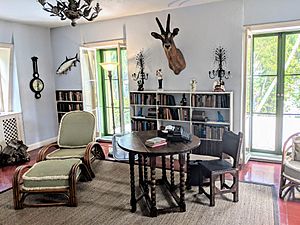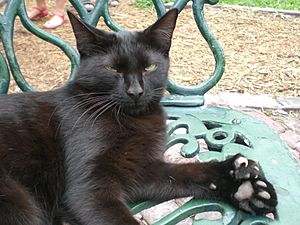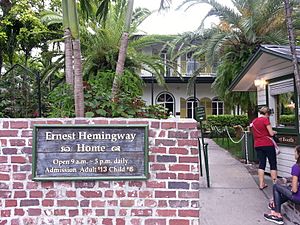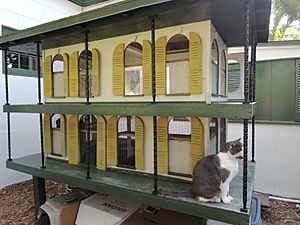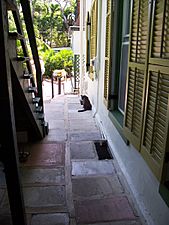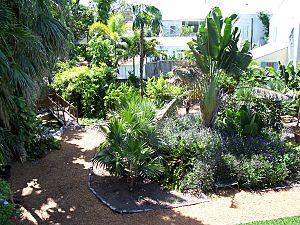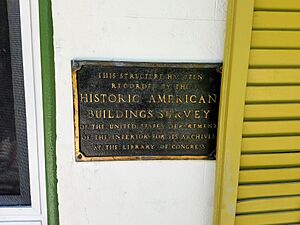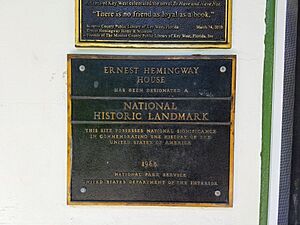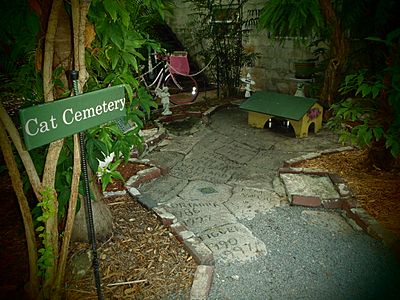Ernest Hemingway House facts for kids
|
Ernest Hemingway House
|
|
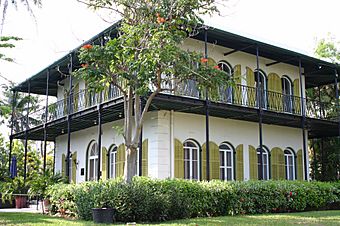
Hemingway House in Key West, Florida
|
|
| Location | 907 Whitehead Street Key West, Florida |
|---|---|
| Built | 1851 |
| NRHP reference No. | 68000023 |
Quick facts for kids Significant dates |
|
| Added to NRHP | November 24, 1968 |
| Designated NHL | November 24, 1968 |
The Ernest Hemingway House was the home of famous American writer Ernest Hemingway in the 1930s. This historic house is located on the island of Key West, Florida. You can find it at 907 Whitehead Street, right across from the Key West Lighthouse. It's also very close to the southern coast of the island.
Because of its connection to Ernest Hemingway, the house is a very popular place for tourists to visit in Key West. It's also well-known for its many cats, often called "Hemingway cats." Many of these cats have extra toes, a special trait called polydactyly.
The house was built in 1851. It was designed in a French Colonial style by a rich marine architect named Asa Tift. Ernest Hemingway and his wife, Pauline Pfeiffer, lived in the house from 1931 to 1939. They fixed up the old house and added new parts to it.
While living here, Hemingway wrote some of his most famous books and stories. These include Green Hills of Africa (1935), and the short stories "The Snows of Kilimanjaro" and "The Short Happy Life of Francis Macomber" (both from 1936). He also wrote the novels To Have and Have Not (1937) and Islands in the Stream (published in 1970 after he passed away).
After Hemingway and Pauline separated, and after their deaths, the house was sold. In 1964, it became a private museum. On November 24, 1968, it was named a National Historic Landmark. This means it's a very important historical place.
Contents
History of the Hemingway House
Building the House
Work on the house started in 1848 and finished in 1851. It was built by Asa Tift, who was a marine architect and also helped rescue things from shipwrecks. He designed it in a French Colonial style, like a large estate.
The house is built on a high spot, about 16 feet (4.9 meters) above sea level. This makes it the second-highest place on the island. Its walls are also very thick, about 18 inches (46 cm) of limestone. These thick walls help protect the house during tropical storms and hurricanes.
Hemingway's Time in Key West
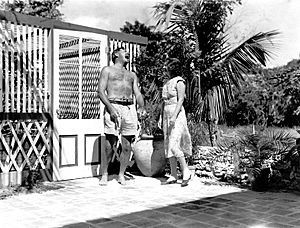
In 1928, writer Ernest Hemingway and his wife Pauline Pfeiffer moved to Key West. They lived in rented homes for three years before finding their permanent house.
When Pauline first saw the house at 907 Whitehead Street, it was in bad shape. It was being taken back by the bank. But Pauline saw its potential. She convinced her rich Uncle Gus to buy it for them as a wedding gift. He paid $8,000 for it. Ernest liked that the 1.5-acre (0.61-hectare) property offered him privacy for his writing.
The Hemingways hired local workers, called Conchs, to help restore the entire house. Pauline chose most of the furniture inside. However, Ernest wanted his hunting trophies to be displayed. Pauline also replaced the ceiling fans with fancy chandeliers, which unfortunately made the air flow less.
The couple also turned the second floor of the carriage house into a writing studio for Ernest. They made the basement into a wine cellar.
While Hemingway was away in Spain in 1937, Pauline had a large swimming pool built. This was the first swimming pool in the Florida Keys. It was huge, 24 by 60 feet (7.3 by 18.3 meters), and held 80,000 US gallons (300,000 liters) of water. It was also very expensive, costing $20,000. This was two and a half times more than the price of the entire house!
When Hemingway returned, he was very angry about the cost. He dramatically threw a penny on the ground, saying, "You might as well take my last cent." But Pauline had paid for it herself. She kept the penny and later had it pressed into the concrete near the pool.
Even though he was mad at first, Hemingway grew to like the pool. He later had a 6-foot (1.8-meter) brick wall built around the property. This allowed him to swim without clothes. Hemingway also kept peacocks on the property and even held boxing matches on the lawn.
While living in this house, Hemingway wrote some of his most famous works. These include Green Hills of Africa (1935), and the short stories "The Snows of Kilimanjaro" and "The Short Happy Life of Francis Macomber" (1936). He also wrote his 1937 novel To Have and Have Not. After his passing, a story was found in a vault in the garage. This work was published in 1970 as Islands in the Stream. After living in the house for eight years, Hemingway moved to Cuba in 1939.
Pauline continued to live in the house until her death in 1951. After that, the house was empty for a while. The ownership of the house stayed in Hemingway's name until his death in July 1961. Later that year, his three children sold the house for $80,000.
The House as a Museum Today
The new owners wanted to live in the Hemingway House as their private home. But so many visitors were interested in seeing it. So, in 1964, they opened the house to the public as a museum. Hemingway's family had taken many of the original furnishings. However, the new owners still had the larger furniture and many of Hemingway's personal items.
Alexa Morgan, who is the Director of Media at the Hemingway Home and Museum, shared some interesting facts. She told Florida Weekly that the museum is open every day of the year. It welcomes between 600 and 800 visitors daily. These visitors include people who love Hemingway's books, historians, and those who enjoy the beautiful gardens. Many animal lovers also come to see the famous cats.
Visitors can explore almost all the rooms in the house. Hemingway's writing room can only be seen through a screen. The property is the most popular tourist attraction in Key West. In 2024, which was 125 years after Hemingway's birth, his home was voted the most popular celebrity landmark in Florida. It was also the 14th most popular nationwide.
In September 2017, Hurricane Irma was heading towards the Keys. The government told everyone on the island to leave. But the museum's curator, general manager, and a team of employees decided to stay. They did not want to leave the house or the cats. Hemingway's granddaughter even told them to evacuate, saying, "It's just a house." But the employees chose to stay with the cats and the house. They all survived the storm safely.
During the COVID-19 pandemic, fewer tourists visited. Because of this, the museum had to let go of over 30 employees. This was half of their staff.
The estate was again threatened by Hurricane Ian in late September 2022. Before the storm, Hemingway's granddaughter, actress Mariel Hemingway, worried that the house might be destroyed. She said it would be very upsetting if any of his homes were damaged. Luckily, the museum was only closed for one day. Director Alexa Morgan said the home had only minor damage. All 59 cats were safe. The cats stayed in a secure area, and a few staff members stayed to feed them.
The Famous Hemingway Cats
The house and its gardens are home to dozens of cats. In 2024, there were 59 of them! They are often called Hemingway cats.
The Hemingway Home website explains that about half of the cats have extra toes. This is called the polydactyl trait. Even cats with the usual number of toes still carry the polydactyl gene. This means they can have kittens with six toes. Most of these cats have extra toes on their front feet. Sometimes they have them on their back feet too. Their paws can look like they have a thumb, like they are wearing mittens.
Key West is a small island, so many of the cats there might be related. Polydactyl cats are not a special breed. This trait can appear in any type of cat, like Calicos, Tabbies, or black cats. They come in all shapes, sizes, colors, and have different personalities. Hemingway used to name all his cats after famous people. The museum continues this tradition today.
About half of the cats have six toes on each paw. The cats are named after celebrities like Humphrey Bogart or Marilyn Monroe. They even have their own cemetery in the house's garden. Media Director Morgan says the staff gets excited when new kittens are born. She explains that they get to vote on the names. They choose names of famous people who lived around Hemingway's time. For example, they have a cat named John Wayne. And because she was born when Hemingway was alive, they even have a Betty White, since the actress loved animals.
A popular story says that all the cats on the property are related to a white, six-toed cat named Snow White. This cat was supposedly a gift to the Hemingways from a sea captain. However, Hemingway's niece, Hilary, and his son, Patrick, have both said that Hemingway did not own cats in Key West. A neighbor supposedly owned several polydactyl cats. Some, like Hilary, think these are the ancestors of the Hemingway cats. There is a photo of a young Patrick and Gloria (Hemingway's daughter) playing with a white cat in Key West. But Patrick said he could not remember the event.
From 2003, the museum had a long legal fight for nine years. It was against the United States Department of Agriculture (USDA). The USDA usually regulates zoos and circuses with big cats. They argued that the museum was like a zoo because the cats were an exhibit. The USDA even sent secret agents to watch the cats in 2005 and 2006. The museum owners fought against the USDA's claims in court.
In 2005, an investigator from People for the Ethical Treatment of Animals (PETA) checked on the cats. They said, "What I found was a bunch of fat, happy and relaxed cats." Finally, in 2012, a court decided that the Animal Welfare Act did apply. This was because the museum used the cats in advertisements and sold cat-themed items.
Gallery
See also
- Birthplace of Ernest Hemingway
- Ernest and Mary Hemingway House
- Ernest Hemingway Cottage
- List of residences of American writers




